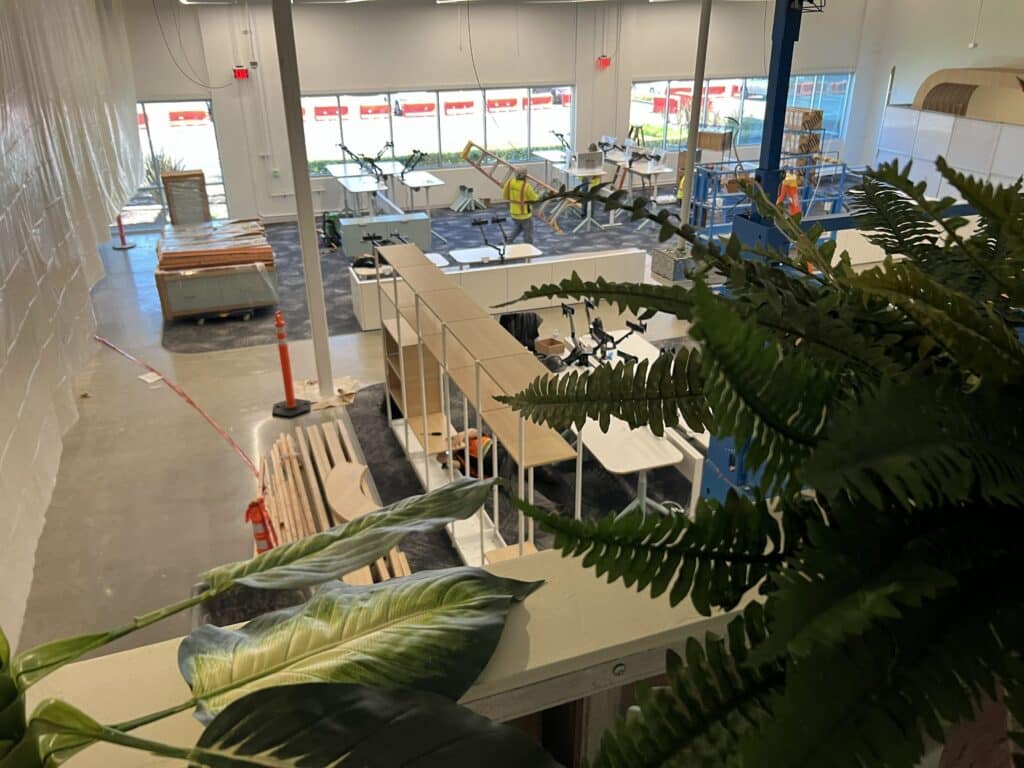In modern office design, addressing “dead space”—those unused, awkward areas—is a common challenge. Fortunately, incorporating plants offers a simple, cost-effective solution. In addition to providing color, plants improve the aesthetics of the office, enrich the air, and make it cozier and healthier. Whether filling an empty corner or brightening a hallway, greenery can transform neglected spaces into vibrant, functional areas. In this post, we’ll explore how plants solve the dead space problem in office design.
Benefits of Incorporating Plants into Office Spaces
More than merely filling a gap, adding greenery to empty places has many advantages for staff members and the workplace as a whole.
Enhancing Aesthetics and Ambiance
One of the most immediate benefits of adding plants is the improvement in workplace aesthetics. A lush plant or green wall can add color, texture, and life to dull areas, making the office feel more inviting. A well-designed plant arrangement can turn an otherwise sterile space into a vibrant focal point.
Improving Air Quality
Many common office plants act as natural air purifiers. They absorb pollutants, release oxygen, and help regulate humidity. As a result, the workplace becomes healthier, allowing workers to breathe better and maintain greater attention throughout the day.
Boosting Employee Well-being
The presence of plants has been shown to reduce stress, enhance mood, and improve overall well-being. Research indicates that workers who work in offices with plants are more productive and satisfied with their jobs.
Acoustic Benefits
Plants can also serve as natural sound barriers. Their leaves absorb sound, reducing background noise and creating a quieter, more comfortable work environment—especially in open-plan offices.
Strategies for Using Plants to Revitalize Dead Spaces
When it comes to filling dead space with plants, there are many creative and practical options to consider.
Vertical Gardens and Green Walls
For spaces with little floor area, green walls are a great option. A vertical garden adds visual interest and maximizes space optimization by utilizing otherwise blank walls. In addition to being aesthetically pleasing, these living walls help improve the quality of the air.
Partitioning with Plant Screens
Using plants as natural partitions can create defined areas within open office spaces. Tall potted plants or rows of planters can serve as attractive dividers, offering privacy while improving workplace aesthetics.
Filling Empty Corners and Hallways
Large floor plants, such as fiddle leaf figs or rubber trees, can transform an empty corner into a striking feature. Similarly, placing a series of planters along an unused hallway can make the space feel more intentional and connected to the rest of the office.
Desk Plants for Personal Spaces
For individual workstations, smaller plants like succulents, pothos, or peace lilies add a personal touch while bringing the benefits of greenery directly to employees. This little upgrade may make the area more cheerful and promote a more productive workplace.
Selecting the Right Plants for Office Environments
The secret to making sure plants flourish in an office environment is selecting the appropriate ones.
Low-Light Tolerant Plants
Many offices lack abundant natural light. Luckily, there are plenty of plants that can thrive in these conditions. Low-light conditions are most suited for plants like philodendrons, ZZ plants, and snake plants.
Low-Maintenance Options
For busy workplaces, low-maintenance plants are a must. Succulents, dracaena, and peace lilies require minimal watering and attention, making them perfect for office life.
Air-Purifying Varieties
Plants with a reputation for cleansing the air include bamboo palms, pothos, and spider plants. Incorporating these into your design not only addresses dead spaces but also improves the overall indoor environment.
Maintenance Tips for Office Plants
Office plant maintenance doesn’t have to be difficult.
Establishing a Care Routine
Create a simple schedule for watering and general care. To keep the plants healthy and alive, designate someone to inspect them on a frequent basis.
Involving Employees in Plant Care
Encourage employees to take part in caring for the plants. This can promote teamwork and give everyone a shared sense of responsibility for the office environment.
Reimagine Your Office Environment by Turning Neglected Corners into Highlights
Expensive upgrades are not necessary to solve the dead space issue in workplace design. y incorporating plants thoughtfully and strategically, you can breathe new life into neglected areas, enhance workplace aesthetics, and support space optimization.
From vertical gardens to simple potted plants, there are countless ways to make greenery work for your office. Not only do plants improve air quality and reduce noise, but they also contribute to employee well-being and productivity. Take a closer look at your own workspace and consider how plants can help you transform dead spaces into vibrant, purposeful parts of your office.
Ready to transform your office and eliminate dead spaces? Let The Wright Gardner help you create a vibrant, healthy workspace with expertly designed plant solutions. For a customized consultation and to learn how greenery may improve the appearance, morale, and productivity of your workplace, get in touch with us now!

